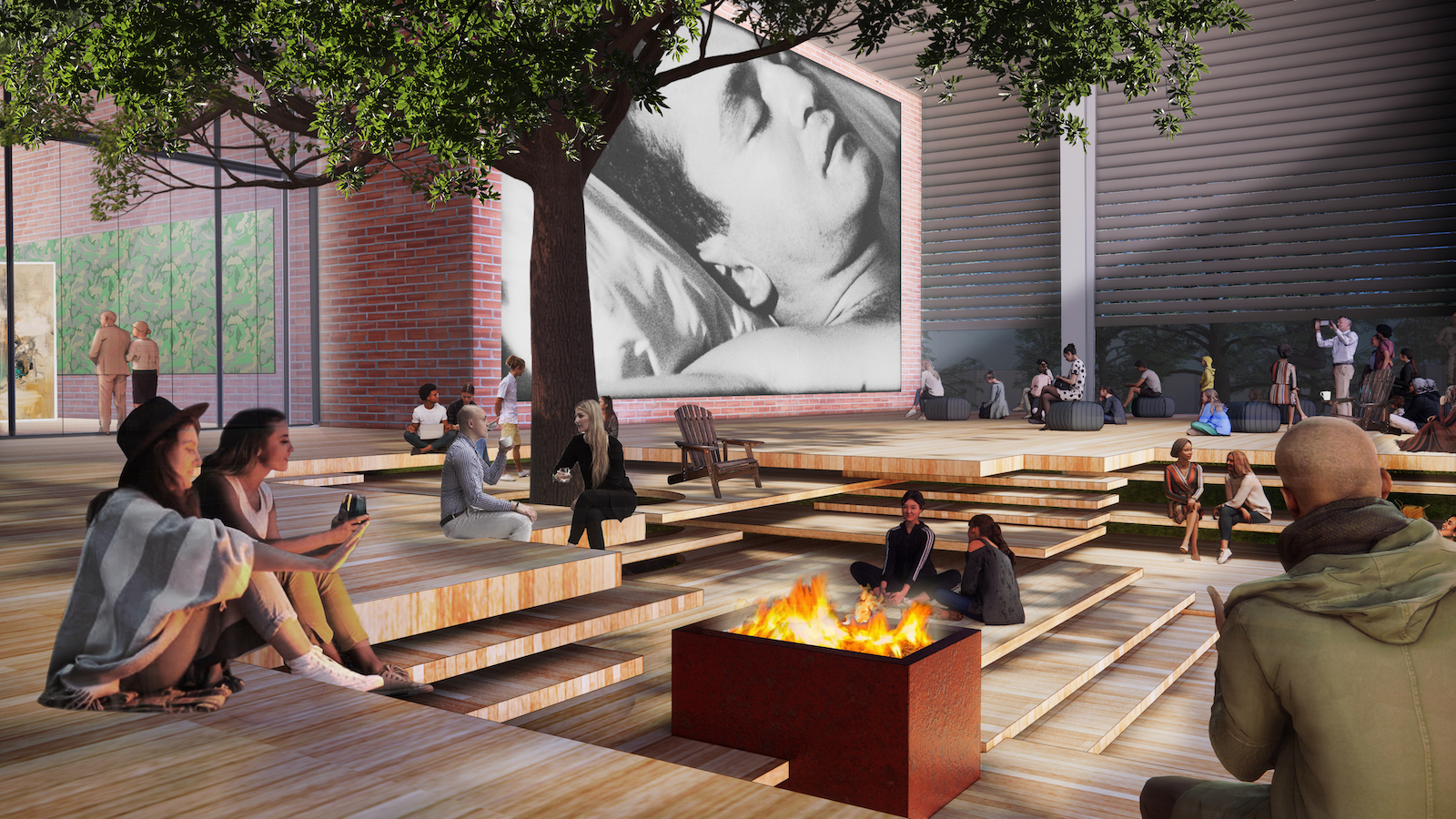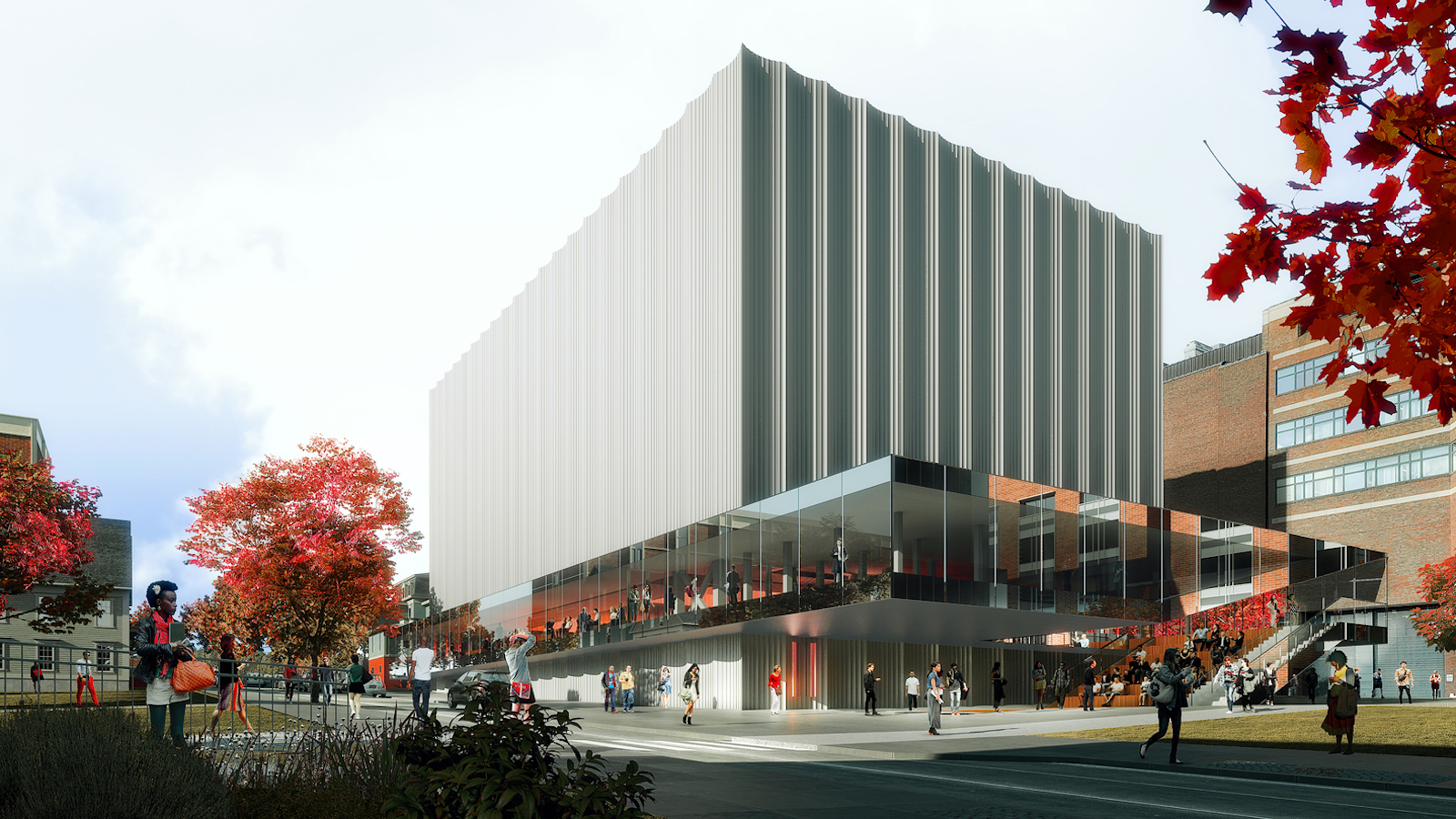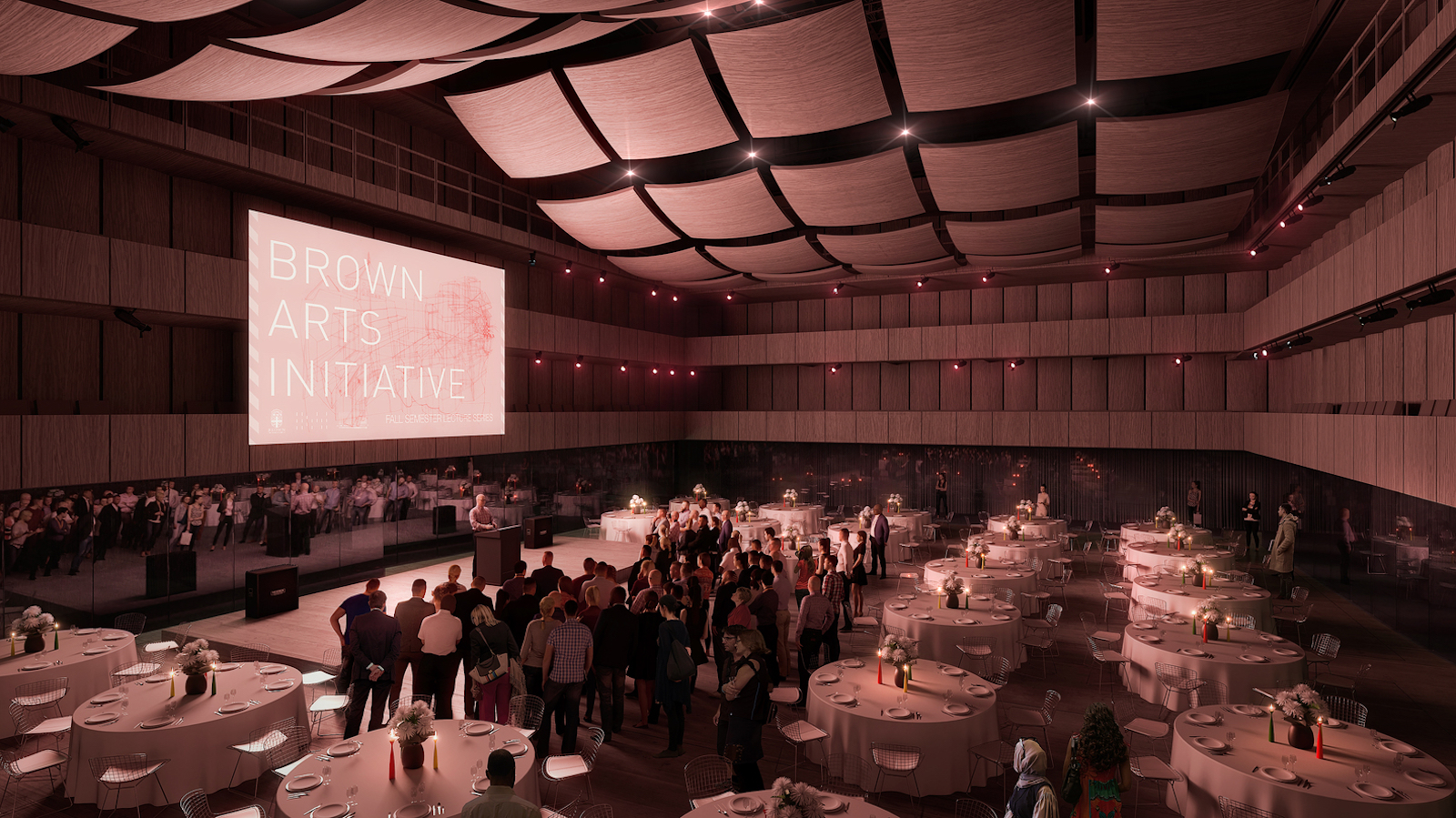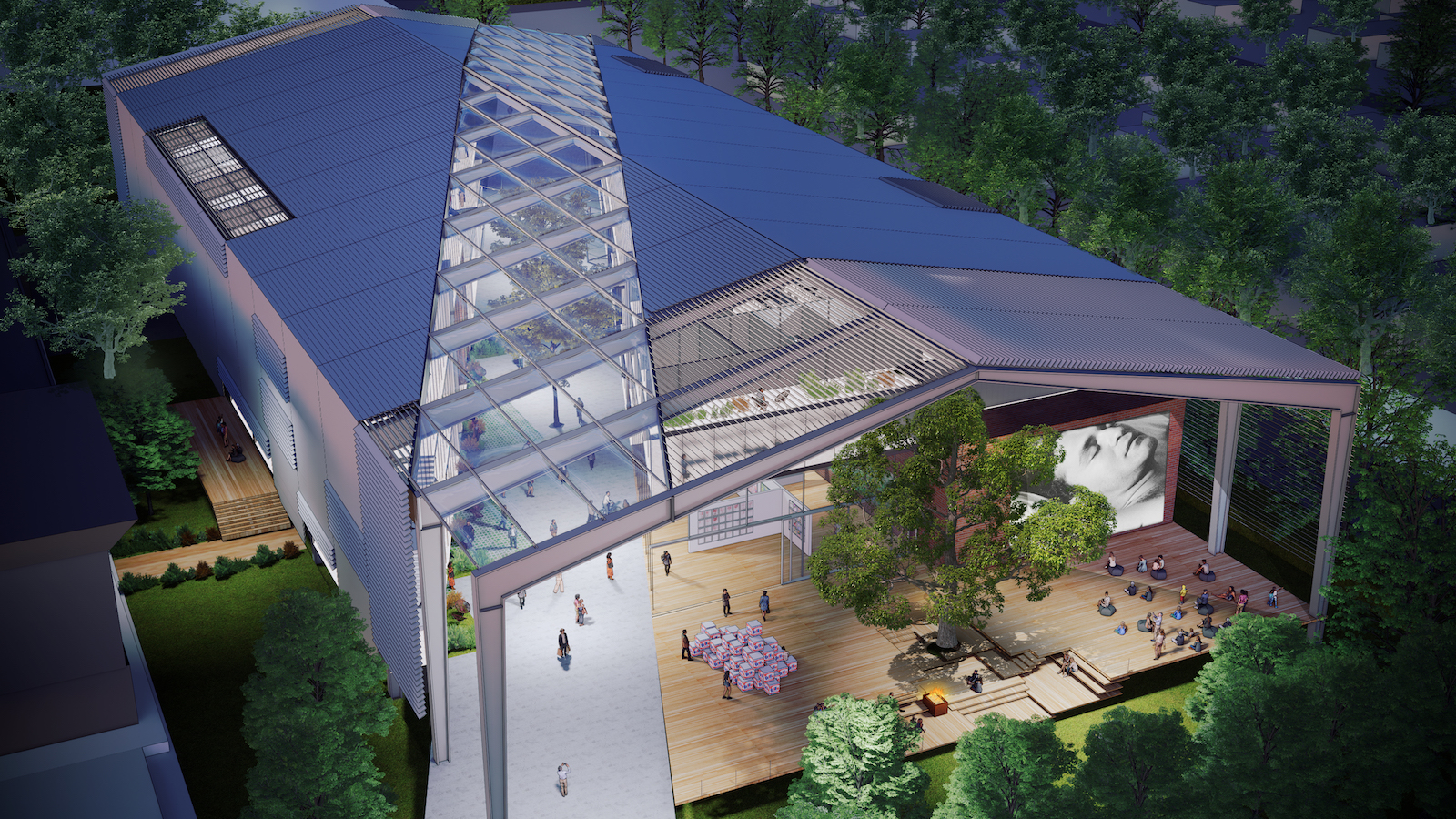A decade or so ago, Voith & Mactavish Architects was doing a lot of performing arts center design for independent secondary and prep schools. “In some ways, higher ed is now catching up” with the expectations of students, explains Daniela Voith, VMA’s Founding Partner and Director of Design, about cultural-related projects her firm has done for universities and colleges lately.
One recent example was the $60 million, 84,000-sf John and Joan Mullen Center for the Performing Arts at Villanova University in Pennsylvania. The LEED Silver-certified building, which was completed in the spring of 2020, is part of a major capital campaign to redevelop the campus’s southern area. The center features two theaters, with 400 and 200 seats respectively, and a 75-seat performance lab. VMA collaborated with Robert A.M. Stern Architects on the art center’s design. Bala Engineering, O’Donnell & Naccarato, and Nave Newell were the project’s engineers, and LF Driscoll provided construction management. The General Building Contractors Association bestowed its 2020 Best Cultural Institution Project Award on this arts center.

Voith isn’t alone in her belief that there’s a renewed recognition among universities that art and creativity “are part and parcel with what makes America succeed.” She also thinks that new and renovated arts centers can be weapons in the “arms race” being waged by universities and colleges that are raising their facilities and amenities to state-of-the-art levels to lure and retain students and faculty.
It might also be a coincidence, but several high-profile arts-related projects are in various stages of development or completion at a time when college enrollment in the U.S. in 2021 dropped for the second straight year, according to recent data from the National Student Clearinghouse Research Center, which estimates that enrollment was down 6.5 percent from pre-pandemic levels.
Integrating Arts And Education in Higher Education

In December, Princeton University in New Jersey—which, in truth, has no trouble attracting student applicants—started construction on its new Art Museum, which at 144,000 sf doubles the size of the museum it is replacing. Designed by Adjaye Associates in collaboration with Cooper Robertson, the three-story Princeton University Art Museum will be a grid of nine pavilions showcasing selections from the museum’s expansive and growing collection, which numbers more than 112,000 items. The building will also house Princeton’s Department of Art and Archeology, and Marquand Library. James Corner Field Operations is the project’s landscape architect, and LF Driscoll provided pre-construction services. The museum is scheduled for completion in 2024. In the interim, the museum will operate two gallery spaces in downtown Princeton, and is planning two outdoor exhibit spaces.
That same month, on December 10, a building team led by the construction management firm Shawmut Design and Construction and the architecture firm REX, celebrated a virtual topping off of Brown University’s 94,000-sf Performing Arts Center, which is scheduled for completion in the spring of 2023, and is utilizing integrated project delivery that incorporates subcontractors and the university into all phases of the project.
The vision for this PAC supports Brown’s 10-year strategic plan, Building on Distinction: A New Plan for Brown (2013), which commits the university to integrative scholarship, educational leadership, academic excellence, and campus development. “Brown is committed to the full integration of the arts into a complete liberal arts education,” the university states on its website. “We know that addressing some of the world’s most vexing challenges benefits from the creative problem-solving enabled by people who have studied and experienced the arts.”
The performing arts center will anchor a future arts district on Brown’s campus in Providence, R.I. Its main performance hall will feature five radically different preset spatial, acoustic, and technical configurations, from a 625-seat symphony orchestra to a 250-seat proscenium theater; as well as three smaller performance and rehearsal spaces below street level where students and faculty can create art works collaboratively. The building’s exterior aluminum rainscreen will appear to shift in color and pattern with time-of-day and seasonal changes.
The performing arts center project is anticipated to achieve a minimum of LEED silver certification. (Brown’s stated policy is not to release cost information until a project is completed.)
Recalling the Past, Without the Obsolescence

Another arts education project that’s drawn attention is Diller Scofidio + Renfro’s (DS+R) design for the Susan and Fayez Sarofim Hall, a $25 million, 50,000-sf building for visual and dramatic arts students, situated on the Houston campus of Rice University. Sarofim Hall, which is scheduled to break ground this year and be completed in 2024, will add to Rice’s already vibrant cultural district that includes the Moody Center for the Arts (which opened in 2017), the newly constructed Brockman Hall for Opera, and Shepherd School of Music’s Alice Pratt Brown Hall.
Rice’s Visual and Dramatic Arts department is one of the university’s most popular, with 900 students per year.
“Cross-disciplinary discourse is a hallmark of the arts in the 21st century, but it has been difficult at Rice since its facilities are scattered all over campus,” observes Charles Renfro, a Partner at DS+R and a Rice graduate. “Sarofim Hall will not only bring these programs together for the first time, but also facilitate experimentation and collaboration between disciplines through open, transparent, indoor/outdoor and public-facing space.”
DS+R’s design recalls the campus’s now-defunct Art Barn and Rice Media Center, which date back to the late 1960s, and the mass-produced pre-engineered metal structures that were popular after World War II. (Art Barn, which was officially known as the Institute for the Arts, was torn down in 2014, and The Media Center is being razed to make way for Sarofim Hall.)
The prefabricated Sarofim Hall will incorporate exhibition areas, labs, studios, shops, faculty offices, and other collaborative spaces for artists across all media. The building’s design frees the steel frame from its skin, and blurs the boundaries between maker and exhibition spaces.
The studios and facilities are designed to guard against obsolescence by encouraging students to fashion their work areas according to their artistic needs. “The building shell is thought of as a piece of infrastructure: simple, durable, and timeless, while the insides can transform as needs change,” Renfro is quoted as saying.
Sarofim Hall’s distinguishing characteristics include Art Street, a glass-lined walkway that cuts diagonally through the four-story building and will serve as a new entrance to the university; and West Porch, a covered outdoor area for such programming as classes, exhibits, and film screenings.
“DS+R’s initial concept for the new building cleverly weaves the symbolism of that history with the scale, materiality, and ‘porosity ’of the broader campus fabric,” adds University Architect George Ristow. “With the building being at the outward-facing perimeter—and at an entrance into campus that has evolved into one of the most active and dynamic access points—it will undoubtedly have a different kind of visibility beyond the hedges that will be leveraged as a new and unique gateway to the Rice arts corridor.”
The project team for Sarofim Hall includes Jackson & Ryan Architects (executive architect), OJB Landscape Architecture (LA), Fisher Dachs Associates (theater consultant), Threshold (acoustics/AV), Martinez Moore (SE), Walter P Moore (CE), and Wylie Associates (MEP). The university did not identify the project’s construction manager or general contractor.
Related Stories
Higher Education | Sep 18, 2024
Modernizing dental schools: The intersection of design and education
Page's John Smith and Jennifer Amster share the how firm's approach to dental education facilities builds on the success of evidence-based design techniques pioneered in the healthcare built environment.
Libraries | Sep 12, 2024
How space supports programming changes at university libraries
GBBN Associate Sarah Kusuma Rubritz, AIA, uses the University of Pittsburgh's Hillman Library to showcase how libraries are transforming to support students’ needs.
University Buildings | Sep 4, 2024
UC San Diego’s new Multidisciplinary Life Sciences Building will support research and teaching in both health and biological sciences
The University of California San Diego has approved plans for a new Multidisciplinary Life Sciences Building, with construction starting this fall. The 200,000-sf, six-level facility will be the first building on the UC San Diego campus to bridge health science research with biological science research and teaching.
University Buildings | Aug 12, 2024
Planning for growing computer science programs
Driven by emerging AI developments and digital transformation in the business world, university computer science programs are projected to grow by nearly 15% by 2030.
Education Facilities | Aug 4, 2024
A former supersonic wind tunnel becomes a new educational facility for transportation design
The Mullin Transportation Design Center at ArtCenter College of Design in Pasadena, Calif., provides access for full-scale vehicular models, replicating a professional design studio.
University Buildings | Aug 1, 2024
UC Riverside’s student health center provides an environment on par with major medical centers
The University of California, Riverside's new Student Health and Counseling Center (SHCC) provides a holistic approach to wellness for students throughout the UC Riverside campus. Designed by HGA and delivered through a design-build partnership with Turner Construction Company, SHCC provides healthcare offerings in an environment on par with major medical centers.
Student Housing | Jul 31, 2024
The University of Michigan addresses a decades-long student housing shortage with a new housing-dining facility
The University of Michigan has faced a decades-long shortage of on-campus student housing. In a couple of years, the situation should significantly improve with the addition of a new residential community on Central Campus in Ann Arbor, Mich. The University of Michigan has engaged American Campus Communities in a public-private partnership to lead the development of the environmentally sustainable living-learning student community.
Adaptive Reuse | Jul 30, 2024
Empty mall to be converted to UCLA Research Park
UCLA recently acquired a former mall that it will convert into the UCLA Research Park that will house the California Institute for Immunology and Immunotherapy at UCLA and the UCLA Center for Quantum Science and Engineering, as well as programs across other disciplines. The 700,000-sf property, formerly the Westside Pavilion shopping mall, is two miles from the university’s main Westwood campus. Google, which previously leased part of the property, helped enable and support UCLA’s acquisition.
Smart Buildings | Jul 25, 2024
A Swiss startup devises an intelligent photovoltaic façade that tracks and moves with the sun
Zurich Soft Robotics says Solskin can reduce building energy consumption by up to 80% while producing up to 40% more electricity than comparable façade systems.
Great Solutions | Jul 23, 2024
41 Great Solutions for architects, engineers, and contractors
AI ChatBots, ambient computing, floating MRIs, low-carbon cement, sunshine on demand, next-generation top-down construction. These and 35 other innovations make up our 2024 Great Solutions Report, which highlights fresh ideas and innovations from leading architecture, engineering, and construction firms.

















